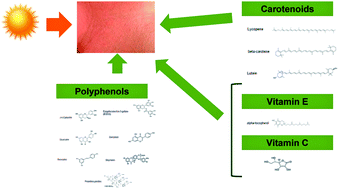Skin protection against UV light by dietary antioxidants
Abstract
There is considerable interest in the concept of additional endogenous photoprotection by dietary antioxidants. A number of efficient micronutrients are capable of contributing to the prevention of UV damage in humans. These compounds protect molecular targets by scavenging reactive oxygen species, including excited singlet oxygen and triplet state molecules, and also modulate stress-dependent signaling and/or suppress cellular and tissue responses like inflammation. Micronutrients present in the diet such as carotenoids, vitamins E and C, and polyphenols contribute to antioxidant defense and may also contribute to endogenous photoprotection. This review summarizes the literature concerning the use of dietary antioxidants as systemic photoprotective agents towards skin damage induced by UVA and UVB. Intervention studies in humans with carotenoid-rich diets have shown photoprotection. Interestingly, rather long treatment periods (a minimum of 10 weeks) were required to achieve this effect. Likewise, dietary carotenoids exert their protective antioxidant function in several in vitro and in vivo studies when present at sufficiently high concentration. A combination of vitamins E and C protects the skin against UV damage. It is suggested that daily consumption of dietary polyphenols may provide efficient protection against the harmful effects of solar UV radiation in humans. Furthermore, the use of these micronutrients in combination may provide an effective strategy for protecting human skin from damage by UV exposure.


 Please wait while we load your content...
Please wait while we load your content...